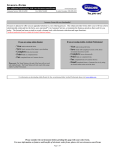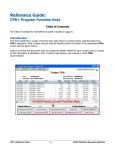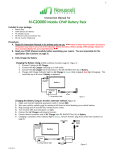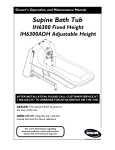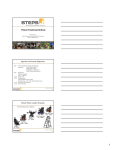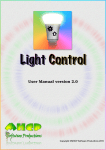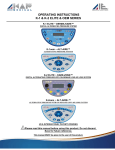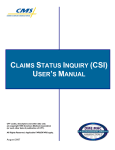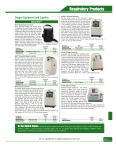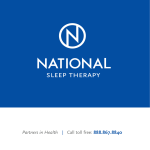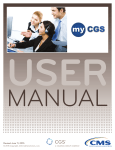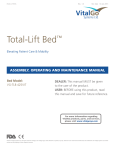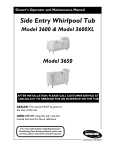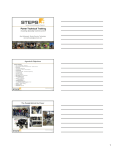Download Jurisdiction B Council A-Team Questions
Transcript
Jurisdiction B Council A-Team Questions Sorted by A‐Team January 2008 Disclaimer: The Jurisdiction B Council A‐ Team Participants have provided the following questions. The answers and references cited are correct as of the publication date. TriCenturion, the Program Safeguard Contractor for Jurisdiction B has provided input on questions pertaining to Medical Policy and Benefit Integrity. These questions are denoted with an *. Home Medical Equipment 1. Proper use of the KB modifier ‐ Is the KB modifier used in situations where a beneficiary upgrade is being provided and an overflow of modifiers results? When submitting a claim, should only the KB modifier be included in block 24d, or should the KB modifier be listed fourth with the additional modifiers listed in the additional documentation field? The KB modifier should be utilized in situations for upgrades when more than four modifiers are required. When submitting a claim with a KB modifier, the supplier should indicate the pricing modifiers (i.e. NU and KH) on the claim line first followed by an information modifier (i.e. LT). Finally, place the 4th modifier on the claim line, which would be the KB modifier in this situation (i.e., RRKHLTKB). The remaining modifiers would then be reported in box 19 of the CMS 1500 paper claim form or in the NTE segment field of an electronic claim. Is the 99 modifier required in all other situations? The 99 modifier is required in cases where more than four modifiers are required on a claim and a beneficiary upgrade is not involved. When submitting a claim with the 99 modifier, the supplier should indicate the pricing modifiers (i.e., RR and KH) on the claim line first followed an information modifier (i.e., LT). Finally place the 4th modifier on the claim line, which would be the 99 modifier in this situation (i.e., RRKHLT99). The supplier would then need to report all modifiers indicated on the claim line including the remaining modifiers in box 19 of the CMS 1500 paper claim form or in the NTE segment field of an electronic claim. 2. A supplier has received two Redetermination Request Acknowledgement Letters for claims that were neither paid nor denied. Redetermination requests were never made. What would prompt National Government Services to generate such a letter? When National Government Services receives a redetermination request, it is entered into the Medicare system with all applicable claim(s) and assigned a Document Control Number (DCN). The Medicare system will automatically generate an acknowledgement letter, acknowledging the receipt of the appeal request, to the appellant. National Government Services researched the DCNs for this example and confirmed that the claims at issue for each DCN were fully adjudicated by the Medicare Processing System. 3. If a supplier picks up a product for repair, the beneficiary will then be without a product so the supplier provides the beneficiary with loaner equipment. Upon a detailed inspection in the shop, the supplier determines that the equipment is indeed irreparable and needs to be replaced (assuming the equipment is older than 5 years). Would a supplier be able to submit a claim for the loaner equipment (HCPCS K0462) in this situation? Medicare guidelines will allow for a loaner wheelchair (K0462) if the parts for the patient owned wheelchair have been ordered or if the repair takes more than 24 hours to complete and if the beneficiary cannot complete their MRADL’s without this particular product. 4. According to instructions in the manual, if a doctor orders a fully electric bed, which is always downcoded by Medicare to a semi‐electric, this cannot be considered an upgrade. If the doctor ordered the E0265 and it must be billed on one claim line. The instruction states that if beneficiary agrees to be financially liable, supplier may collect the difference. The patient is informed and willing to pay the difference and signs an Advance Beneficiary Notice. Is it correct that this would be acceptable on a non‐ assigned claim but not on an assigned claim? On an assigned claim, the remit comes back with an E0260 CC and a code of CO45. Claim submission for upgraded items is not based upon whether or not the supplier accepts assignment. When a supplier furnishes an upgraded item of DMEPOS and the supplier expects Medicare to reduce the level of payment based on a medical necessity partial denial of coverage for additional expenses attributable to the upgrade, the supplier must give an ABN to the beneficiary for signature for holding the beneficiary liable for the additional expense. Jurisdiction B Council A‐Team Questions January 2008 2 A supplier furnishing an upgrade and using an ABN must submit a claim and include information on the claim that identifies the upgrade features. Suppliers must submit a claim for upgraded items and services using the GA modifier on the upgraded line item to indicate that the beneficiary signed an ABN. Suppliers must bill 2 line items for upgraded DMEPOS items where the beneficiary requests an upgrade. Suppliers must bill both lines on the same claim in the following order: Line 1: Bill the appropriate HCPCS code for the upgraded item the supplier actually provided to the beneficiary with the dollar amount of the upgraded item. If the supplier has a properly obtained ABN on file signed by the beneficiary, use the GA modifier. If the supplier did not properly obtain an ABN signed by the beneficiary, use the GZ modifier. Line 2: Bill the appropriate HCPCS code for the reasonable and necessary item with the actual charge for the item. Use the GK modifier. Example: Line 1 – E0265RRKHGA Line 2 – E0260RRKHKXGK 5. If the doctor has ordered a semi‐electric hospital bed (E0260) and the patient wants a total electric hospital bed (E0265). Assigned claim will be billed on 2 lines as follows: E0265RRKHGA E0260RRKHKXGK $250.00 (supplier’s usual charge) $170.00 (supplier’s usual charge) Assuming claim is payable, how should it appear on the remit? Will it indicate beneficiary liability in the correct amount? The claim line with the GA modifier will be denied as not medically necessary with a “patient responsibility” (PR) message denial and the claim line with the GK modifier will continue through the usual Medicare claims processing system. 6. Suppliers are aware that oxygen CMNs have to be recertified after the first year. However, does this rule apply to all DME capped rental items such as Wheelchairs, Hospital beds, Nebulizers, CPAPS etc? Recertification rules do not apply to all DME capped rental items. Suppliers are encouraged to review the “Documentation Requirements” section of Local Coverage Jurisdiction B Council A‐Team Questions January 2008 3 Determinations (LCDs) to determine if and/or when recertification rules apply. The LCDs are located on the TriCenturion Web site at www.tricenturion.com. Enteral/Parenteral/IV Therapy No Questions Submitted Respiratory Care Equipment/Oxygen Therapy 7. Can suppliers bill the patient directly for a second concentrator (E1390) if we are taking assignment on the first concentrator (E1390)? If this is allowed, would the proper documentation indicated on the ABN state “duplicate equipment?” Medicare patients may be held liable if the back up equipment is deemed unreasonable and necessary by the Medicare Contractor. Suppliers must properly execute an Advance Beneficiary Notice (ABN) advising the patient of their financial liability in the event of a denial due to same or similar equipment already in use. For documentation purposes, the supplier must indicate in detail on the ABN why the claim is not medical necessary for the patient and the supplier must add the GA modifier to the claim. 8. In respect to when the 36‐month cap takes place on oxygen equipment. Currently, some of patients have a Conserving Portable with small M6 tanks and a satchel, while others have the traditional Cart, Regulator, and E‐tanks. In addition, our patients vary widely in the number of tanks they have and use. When the rented portable systems cap as purchased, what exactly becomes patient‐owned? We have traditionally considered one tank as part of a purchased system. Does this conform to Medicare policy? Will the patient own the same type of system that they have been using? Some patients will end up owning different types of equipment. We foresee problems down the road when patients and families start comparing notes on what Medicare has purchased for them. The Centers for Medicare and Medicaid Services (CMS) has not provided instructions for this specific issue. As soon as instructions are released, the Jurisdiction B DME MAC will provide education via listservs, information will be added to the supplier manual, and information will be included in the next scheduled bulletin. 9. Will home fill (K0738) be capped out at 36 months or not? If we have to send these claims as Redetermination requests, will the original CMN for portable (E0431) oxygen along with the doctorʹs order suffice (because K0738 will not be on the original CMN)? Will we need to add K0738 to the original CMN? See response to question #8. Jurisdiction B Council A‐Team Questions January 2008 4 10. Is the DME MAC aware of any updates to the fee schedule for oxygen parts (liquid or concentrator)? See response to question #8. 11. Is ICD‐9 code 327.23 the only code that can be used from now on by suppliers and all doctors for CPAP coverage? Until suppliers can get all sources educated, what happens if the physician uses 780.57 or 780.53? Do suppliers have to call the physicians back and have them change it or can suppliers change the diagnosis code to 327.23 if the sleep study states the patient has Obstructive Sleep Apnea? In previous revisions of the Local Coverage Determination and Policy Articles for Continuous Positive Airway Pressure Devices (CPAP) there was not a specific ICD‐ 9 code for Obstructive Sleep Apnea (OSA). On October 1, 2005, the ICD‐9 code (327.23) was established for Obstructive Sleep Apnea. The policy is very specific regarding the diagnosis that is required in order to meet coverage criteria. Therefore, the ICD‐9 code should be used for CPAP claims instead of the general sleep apnea code. The policy indicates that the CPAP device is only covered for a diagnosis of OSA but the policy currently does not specify a diagnosis set. The CPAP medical policy will be updated to reflect the OSA diagnosis code 327.23. Until the medical policy has been updated, the diagnosis sets for unspecified sleep apnea can be used as long as the supplier has documentation supporting the diagnosis. The Jurisdiction B DME MAC has issued an article titled “Continuous Positive Airway Pressure (CPAP) Devices” to reiterate the importance of documentation and the use of the OSA ICD‐9 code. This article has been educated to both the Part B and DME provider communities. Prosthetics/Orthotics No Questions Submitted Rehab Equipment 12. A supplier was told on an Advance Determination of Medicare Coverage (ADMC) for a power wheelchair that the detailed product description must be dated after the initial order. Can this be confirmed or denied? In this example, it was the same date, which is not precluded from happening per policy. (Example available) The detailed product description can be dated either the same date or after the completed seven‐element order. It is not a typical practice for the seven‐ element order and the detailed product description to be completed on the same date, but it is possible as long as the seven‐element order contains all required documentation. Jurisdiction B Council A‐Team Questions January 2008 5 13. Power Chair documentation: If a power chair was delivered in July with all appropriate documentation and in September, in response to a patient request, the equipment was switched out for a different make and model (same HCPCS code). The September delivery was still within 120 days of the face‐to‐face Examination. Can the detailed product description be changed, initialed and dated by the ordering physician since only the make and model has changed? Yes, the detailed product description can be changed by the treating physician as long as it is for the same HCPCS code and does not change any coverage criteria requirements. The physician would need to initial and date the change. 14. Is the KX modifier required for parts and accessories for manual wheelchairs (assuming they qualify)? The KX modifier is only required for the manual wheelchair base if coverage criteria per the Local Coverage Determination policy is met. 15. If we have a patient who meets the qualifications for K0843 heavy‐duty power wheelchair with the exception of weight (i.e. patient’s weight is 297 pounds and the qualifying weight for a K0843 is 301 pounds), but they really are too heavy to use a standard weight capacity chair. Does Medicare make an allowance as far as weight or would this chair be downcoded to K0842? Dr. Edwards stated verbally at a SADMERC meeting that there was a 20lb ‘allowance’ (i.e., that if the patient weighed within 20 lbs of the cut‐off number, we could provide the higher weight capacity chair); is that true and accepted by Jurisdiction B? If so, can this be spelled out in policy? If no exception is allowed and the patient gains 10 pounds in the next 6 months (thus exceeding the weight capacity of the chair they currently qualify for), would Medicare pay for another new wheelchair that meets the patients new weight needs? Medicare takes into consideration weight fluctuation and if it is the first time a beneficiary has been placed in a wheelchair weight gain is likely. TriCenturion, the Program Safeguard Contractor will allow for a weight variance as long as documentation is obtained from the treating physician regarding the patient’s weight. The documentation must indicate the patient has a history of weight fluctuation or if the physician, supplier, and patient believe that it is likely that the patient may gain weight from being placed in a wheelchair. If the patient’s history shows they have been in a wheelchair for 10 years and have had a consistent weight within that timeframe then the coverage of the wheelchair solely based on a weight increase would not be considered medically necessary. Jurisdiction B Council A‐Team Questions January 2008 6 16. If a supplier is providing a waiver upgrade for a power wheelchair, how should the product(s) be listed on the detailed product description prescription? a. Do we list the model we are actually providing, or the model/code the beneficiary qualifies for, or both? b. Does it make a difference whether this is a ʹfreeʹ upgrade, or one where the beneficiary is paying the difference? c. Please provide actual examples. For example, if a beneficiary qualifies for a Group 3 no power sling/solid seat power wheelchair, code K0848, but they are getting a Group 4 no power sling/solid seat power wheelchair, code K0868. Code K0848 K0868 Model Invacare TDX SP Invacare 3G Torque SP Billed Price $5600.00 $6450.00 Allowable $5284.40 n/a Since we are actually providing the 3G Torque SP, and not the TDX SP (though we may have used that model as a comparison), but the claim should process/pay at the K0848 code and allowable. How should this be printed on the detailed product description prescription? No, the upgraded item does not need to be listed on the detailed product description. Only the wheelchair base ordered by the treating physician that the patient meets medical necessity for is required to be on the detailed product description. The upgraded item would be indicated at the claim level. The upgraded item should be indicated at the first line level and the wheelchair that the patient qualifies for should be indicated on the second claim line with the appropriate modifiers. Ostomy/Urological/Medical Supplies 17. Is a general prescription that simply states “ostomy supplies or catheters” sufficient, or does the prescription have to be specific to quantity, product, and HCPCS code? Generally, as noted in Chapter 7 of the Jurisdiction B DME MAC Supplier Manual, the written order (required before submitting a claim to Medicare) must be sufficiently detailed, including all options or additional features which will be separately billed or which will require an upgraded code. The description can be either a narrative description (e.g., lightweight wheelchair base) or a brand name/model number. If the order is for a rented item or if the coverage criteria within a particular policy specify length of need, the order must include the length of need. If the order is for accessories or supplies that will be provided on a periodic basis, the order should include appropriate information on Jurisdiction B Council A‐Team Questions January 2008 7 the quantity used, frequency of change or use, and the length of need. (For example, an order for surgical dressings might specify one 4 × 4 hydrocolloid dressing that is changed 12 times per week for one month or until the ulcer heals.) If the supply is a drug, the order must specify the name of the drug, concentration (if applicable), dosage, frequency of administration, and duration of infusion (if applicable). The detailed description of the item may be completed by someone other than the physician. However, the treating physician must review the detailed description and personally sign and date the order to indicate agreement. For additional instructions regarding physician orders, verbal orders, written orders and written orders prior to delivery; please refer to the Centers for Medicare & Medicaid Services (CMS) Internet‐Only Manual (IOM) Publication 100‐08, Medicare Program Integrity Manual, chapter 5. For specific order requirements, you will need to refer to the applicable Local Coverage Determination. Diabetic Monitoring and Supplies No Questions Submitted Documentation/Regulatory/Miscellaneous/Other 18. The Jurisdiction B DME MAC Supplier Manual, under CMN/DIF completion instructions state the following: The date in Section D must be the date that the physician signs the CMN. Both the signature and date must be personally entered by the physician and may not be a stamp. The Medicare Program Integrity Manual Chapter 5 reads: 5.3.1 ‐ Completing a CMN or DIF The ʺSignature Dateʺ is the date the physician signed and dated Section D of the CMN. This date might not be the same as the ʺInitial Dateʺ, since the ʺSignature Dateʺ must indicate when the physician signed Section D of the CMN. Medicare requires a legible identifier for services provided/ordered. The method used (e.g., hand written, electronic, or signature stamp) to sign an order or other medical record documentation for medical review purposes in determining coverage is not a relevant factor. Rather, an indication of a signature in some form needs to be present. Do not deny a claim on the sole basis of type of signature submitted. Signature and date stamps are acceptable for use on CMNs and DIFs. Jurisdiction Dʹs manual states the same as the Program Integrity manual. Is this documentation requirement one that is put in place by the carrier and can it differentiate from the Social Security Act or Program Integrity Manual? Jurisdiction B Council A‐Team Questions January 2008 8 The Jurisdiction B DME MAC Supplier Manual, Chapter 6, Certificates of Medical Necessity/ DME Information Forms will be updated in the March 2008 revision to show that signature and date stamps are accepted for use on CMNs and DIFs. 19. Our Medicare Secondary Payer claims are currently denying even though we have an ASCA waiver form on file stating that we have fewer than 10 employees. When contacting the Customer Care Department, we are being told our form was sent in on 4/30/07 and our claim is dated 4/l6/07. We now have to submit a Redetermination requests. Has this issue been resolved? This issue has been resolved. If a supplier attempts to submit claims for dates of service prior to the ASCA approval date, the claims will deny. In this case, the ASCA approval was dated 4/30/07 and the supplier had claims with dates of service prior to this approval date. Suppliers that meet an ASCA exception, prior to the ASCA approval date may contact the Customer Care at 1‐877‐299‐7900 to have the ASCA approval date changed. 20. Since Medicare requires suppliers to file MSP claims electronically, could Jurisdiction B DME MAC please provide us with an instruction manual? The Express Plus Electronic Claims User Manual does not provide enough detail on how to file Medicare Secondary Payer (MSP) claims electronically. National Government Services, the Jurisdiction B DME MAC created a MSP Computer Based Training (CBT) course that details the following: • Overview of MSP • Screening of Medicare Beneficiaries • MSP Paper Submission • MSP Electronic Submission • Submitting MSP claims using Express Plus • Resources Each topic referenced above is separated by chapters in the MSP CBT. Suppliers may complete the chapter(s) applicable to them. Chapters can be accessed by clicking on the drop down box at the top right of the screen. Suppliers are encouraged to complete the chapter titled, ʺSubmitting MSP claims using Express Plusʺ. The CBT is located on the new Medicare Learning Management System. The new Medicare Learning Management System can be accessed at www.adminastar.com/Providers/DMERC/MLMS/MLMS.html Jurisdiction B Council A‐Team Questions January 2008 9 21. Has the Jurisdiction B DME MAC considered online capability for claim status, and patient eligibility? Most private insurance companies offers this information online and free of charge. It is a very valuable tool for suppliers and it would also cut down on the number of calls made to Medicare. Suppliers can check the status of pending claims on line by utilizing Claim Status Inquiry. Claim Status Inquiry will allow providers to access the Medicare Processing System to check the status of their previously submitted claims, patient eligibility, and payment history. Additional details regarding Claims Status Inquiry can be access on the National Government Services Web site at www.adminastar.com/Providers/EDI/DMERC/Agreements/Agreements.html 22. Is there a specific timeframe that suppliers need to document patient digression when different equipment is needed? (For example: Patient has a cane but now has an order for a walker; patient has a standard wheelchair but now has an order for a motorized wheelchair) The Medicare regulations do not specify a timeframe needed in order for a beneficiary to qualify for different or a higher capability Mobility Assistive Device (MAE) item. The physicians’ documentation must reflect the digression in the patients’ mobility functions and their need for the new item. For example: The beneficiary had qualified for a walker due to their instability with Parkinson’s. Six months later the beneficiary’s disease has progressed more significantly where they are no longer safe using a walker and they meet the coverage criteria for a manual wheelchair. The physician’s notes must indicate the progression of the patient’s disease and it must state why the patient can no longer use the previous equipment. Jurisdiction B Council A‐Team Questions January 2008 10










